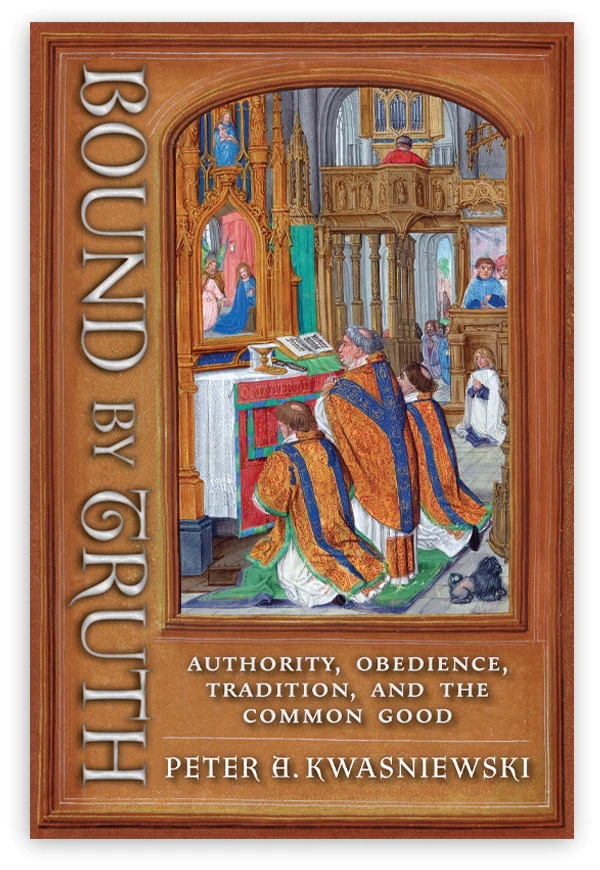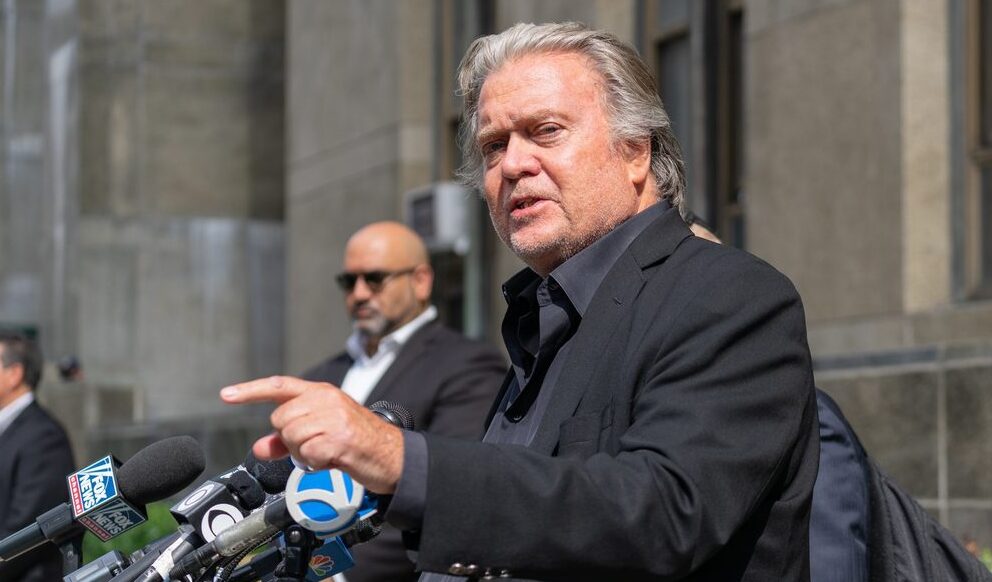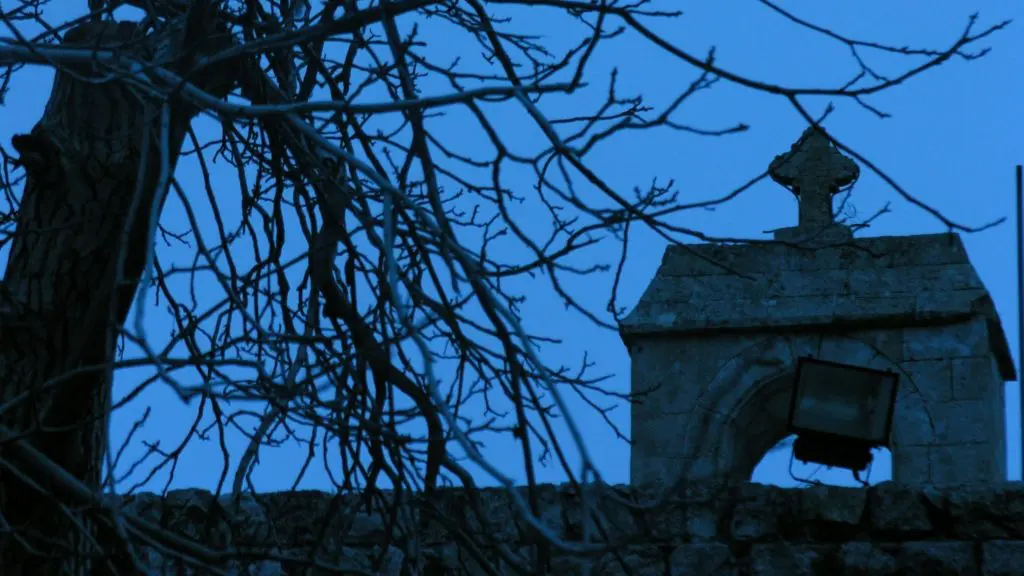On the very day that I finished Dr. Peter Kwasniewski’s latest book, my bishop announced the cancellation of the traditional Latin Mass at our diocesan cathedral, where, for many years, over 500 faithful Catholics have been nourished each Sunday by the ancient treasures of the Roman Rite.
Peter Kwasniewski, an American author and lecturer, is no stranger to the ongoing effort to appreciate and promote these ancient treasures within the Catholic Church. He earned graduate degrees in philosophy at the Catholic University of America and spent most of the past few decades on the faculties of the International Theological Institute in Austria and Wyoming Catholic College, where he taught theology, philosophy, music, and art history. In 2018, he transitioned to work as a full-time writer and lecturer, particularly on the topics of liturgy and music. These efforts have culminated in the publication of several books, the latest of which, Bound by Truth: Authority, Obedience, Tradition, and the Common Good, was released in December 2023 by Angelico Press.
When I started reading Bound By Truth, I expected to gain theoretical understanding of how the concepts in the subtitle are related and apply to hypothetical situations—a salutary exercise in this time of general liturgical crisis in the Church. When my bishop’s grim decree reached my ears, however, I realized the book had served a greater purpose. Unwittingly, I had acquired the resources needed to face the crisis on my own diocesan doorstep—and not a moment too soon.
Before continuing, I wish to preface this review by expressing my deep love and respect for the papal office. As much as reasonably possible, I desire to obey the Holy Father and my local bishop. Divine Providence has placed me under their authority, and rejecting that reality would imperil my salvation. Hence, I approach discussions of authority and obedience in the Church with extreme caution, wary of any rash claims.
Thankfully, Kwasniewski reassured me of his agreement by dedicating early chapters to a reinforcement of Vatican I’s definition of papal authority. The limits that council itself set for the exercise of the papacy are essential for responding to our current crisis. Moreover, according to an interpretation of the dogma of papal infallibility that was approved by Pius IX, the pope is infallible when teaching revealed truth under specific circumstances, but not in legislative matters. However, Kwasniewski cautions that, even when they are not acting infallibly, “We should, and usually do, give legitimate authorities the benefit of the doubt by assuming they are well-intentioned and sincerely working for the common good.” This general posture of submission to Church authority does not eliminate our duty to the common good when it is grievously threatened, as will be discussed below. Nevertheless, it is to the author’s credit that he stakes his claim as a loyal son of the Church from the outset.
I have been an avid reader of Kwasniewski for years, but as the liturgical crisis has escalated, his writing has become more urgent and refined. Ever the careful thinker, he acknowledges the weakness of cookie-cutter solutions. The unprecedented character of our situation as Roman Rite Catholics—consisting of the pope’s imposition of a liturgical rite that was published but never technically promulgated or mandated, together with his removal of multiple apparently orthodox bishops, among other aberrations—draws attention to what Kwasniewski calls the “paradox of traditionalism.” In essence, our commitment to tradition amid exceptional circumstances may require us to adopt unprecedented methods of response. Such responses flow from agreement with Pope Benedict XVI that “it behooves all of us to preserve the riches which have developed in the Church’s faith and prayer, and to give them their proper place.” While this principle remains true, the situation has changed dramatically since the pontiff expressed it in his letter to bishops accompanying Summorum Pontificum nearly 17 years ago. Faithful Catholics find themselves in uncharted territory, striving to protect their inheritance in the face of ever-increasing obstacles sanctioned by churchmen in Rome.
Confronted with this paradox, some may be tempted to adopt a distorted notion of obedience that indiscriminately submits to all papal demands. Other Catholics might rush to the opposite extreme, rejecting any obligation to obey their bishop or the pope. Both extremes are misguided, Kwasniewski warns. What Catholics need (and what reason enjoins) is neither an undiscerning submission nor a rebellious rejection, but “a recalibration of the network of authorities and obediences” inspired by scripture, tradition, and the magisterium.
Jump-starting this recalibration is the aim of Bound by Truth. In chapters that distill and expand upon salient points from his earlier books, Kwasniewski embarks upon a measured consideration of the first principles underlying the issue. In the Church, as in every sphere of life, rulers have real authority to direct their communities. In fact, “The ruler exists in order to foster and protect the common good of the society over which he is placed.” Any exercise of authority, therefore, must have a fundamental orientation to the common good. To remove any suspicion of foul play, Kwasniewski supports his Thomistic reasoning with choice quotations from prelates and Church documents, such as Pope John Paul II’s Catechism of the Catholic Church: “Authority is exercised legitimately only when it seeks the common good of the group concerned and if it employs morally licit means to attain it.”
Thus, the authority of the pope and bishops exists for the common good of the Church. Like any part of that common good, liturgical worship is intimately connected to the purpose and limits of authority and obedience. The liturgy actualizes the twofold purpose of the Church: the glorification of God and the salvation of souls. For this reason, the liturgical traditions of the Church and the faithful’s right to worship in accordance with them have been zealously guarded from papal overreach. Kwasniewski provides consistent testimony from Church history that the pope is bound to tradition. This testimony is drawn from a variety of sources, from eminent canonists and theologians to ecumenical councils to statements from Vatican congregations and recent popes. One is left with the sense that the Church views traditional liturgical rites as treasures to be protected and freely offered, and consequently, in the words of Vatican II’s Sacrosanctum Concilium, they cannot be changed by the pope or anyone else “unless the good of the Church genuinely and certainly requires” it.
What does this mean for obedience? Kwasniewski wisely leans on St. Thomas Aquinas in his response. Despite the negative reputation it has acquired in some circles owing to tragic abuses, obedience is one of the highest virtues enjoined on all. However, it does not exist for its own sake. Obedience is the subject’s opportunity to cooperate with the ruler in pursuit of the common good, as Christ exemplified in his obedience to the Father. The sphere of both authority and obedience is the society’s common good. They cannot depart beyond this limit without violating their natures. Hence, to the extent that a ruler mandates such a departure, subjects are obliged to withhold obedience. If the ruler commands contrary to the common good and the subject submits to an order contrary to the common good, they both violate their duties toward the good of their society.
Kwasniewski anticipates the objection that lay Catholics are incompetent to discern if and when the pope has trespassed the limits of his authority. If this were true, however, it would mean the laity must obey any papal restrictions of the liturgy, no matter how contrary to the common good they might be. Yet no authority can cancel out the dictates of conscience. While needing rational formation through study and prayer, one’s conscience ought always to be obeyed, as the Catechism reminds us. As a helpful litmus test in times of confusion, then, Kwasniewski proposes asking oneself, “Does this make sense given what I have already received from the Church? Does this contradict something that is more fundamental, or something I know with greater certitude?”
To be rightly ordered toward the common good, obedience must always be grounded in truth and charity, “And since we have Scripture plus two thousand years of tradition, as witnessed by the constant teaching and practice of the Church over that span of time, we can know both what truth is, and when authority is failing to serve it—at least in egregious cases.” Testimony from Church history reinforces this position, including the following 2014 statement from the Vatican’s International Theological Commission: “The sensus fidei fidelis confers on the believer the capacity to discern whether or not a teaching or practice is coherent with the true faith by which he or she already lives. … Individual believers may deny assent even to the teaching of legitimate pastors if they do not recognize in that teaching the voice of Christ.” Far from turning Catholics into Protestants, this sense of the faithful equips them to adhere to what the Catholic Church has always believed; it precisely prevents them from being like Protestants who pick and choose what, in the inherited religion, is to be accepted or rejected. Hence, as Kwasniewski explains, “If we are convinced that something essential, something decisive in the Faith is under attack from the pope or any other pastor, we may and must refuse to do what is being asked or commanded.”
Recognizing the truth of this conclusion is one thing, but knowing how to prudently act on it in particular circumstances is another. To aid readers in their effort to practice true obedience, Kwasniewski shifts from a discussion of principles in the first section of the book to an application of them in the second. These pages compile many of the most thought-provoking articles and essays he has published across the internet in recent years. They will be immensely helpful for those who have ever wondered how a bishop should respond to his unjust deposition by the pope, what lay people should do when Masses in a traditional rite are restricted by a bishop, how to regard the SSPX while remaining humbly faithful to the pope and the Church, how to cultivate the good of the Church in an era of liturgical crisis, and the scope of the Sunday obligation. Kwasniewski works toward his practical advice over the course of each chapter, so it will be most appreciated by those who have done the work to arrive at each conclusion, even if they might respectfully disagree.
I found most of Kwasniewski’s arguments to be extremely compelling. However, I disagree with one aspect of what he says, in chapter 21, regarding the Sunday obligation. While affirming that we are always objectively duty-bound to offer God right worship in the manner that He has prescribed, Kwasniewski believes the obligation would not subjectively bind someone who does not have access either to a traditional rite or to a maximally reverent Novus Ordo (e.g., ad orientem, only male ministers, communion while kneeling and on the tongue, etc.). I am left unconvinced. Elsewhere in the chapter, he claims that it “would hardly skew one’s faith” to occasionally attend a maximally reverent Novus Ordo. In my estimation, this can apply to a Novus Ordo with less than maximal reverence as well. It does not seem like occasional attendance at a mostly reverent Mass would be spiritually harmful, so the situation would not meet the qualifications for moral impossibility of attendance, and the individual would thus be bound to attend. Needless to say, I also recognize that having children who are formed and influenced by what they see at Mass is an additional factor that parents must weigh in discerning where to worship. All in all, this is one critique amidst an ocean of praise I have for the book.
There is a danger of becoming discouraged in the face of our present trials and the difficult decisions before us. Yet Kwasniewski offers at least two major reasons to hope and trust in God’s providence. First, just as God used previous Church crises to clarify certain disputed concepts, so too our current crisis “will eventually lead to—and indeed has already begun to produce—a far better, more nuanced, realistic, transfigured understanding of Church authority (especially the nature and limits of the papal office) and the corresponding virtue of obedience.” Second, God “permits delays and setbacks to test our faith and to make it stronger—indeed, unconquerable.” We must stay close to His Church and persevere in prayer, “which demonstrates that we are more attached to Him than to quick results.”
Even if one’s most beloved liturgy is not currently being targeted by prelates aiming to dismantle it, it soon may be. It is vital not to be caught unawares, ignorant of one’s right to traditional liturgy, and unsure of the limits of dutiful obedience. At the very least, faithful Catholics should begin wrestling with the difficult questions, learning what they ought to do if an authority clearly departs from the common good. If the crisis is already at hand, as it is in my diocese, there will be an urgent need for sound thinking informed by scripture, tradition, and the magisterium. The list, in chapter 22, of strategies to safeguard the traditional Latin Mass will help to turn that sound thinking into sound action.
Just as the ability to swim is rightly cherished by both the man comfortably aboard his boat and the man floundering in the water after a capsize, Bound by Truth is an invaluable resource for all Catholics as long as the liturgical maelstrom continues to threaten peaceful passage toward heavenly harbors. Now is not the time to despair—for we know that Christ and His bride, the Church, will prevail. Now is the time to acquire the tools—like this book—that will help us to practice true obedience.







